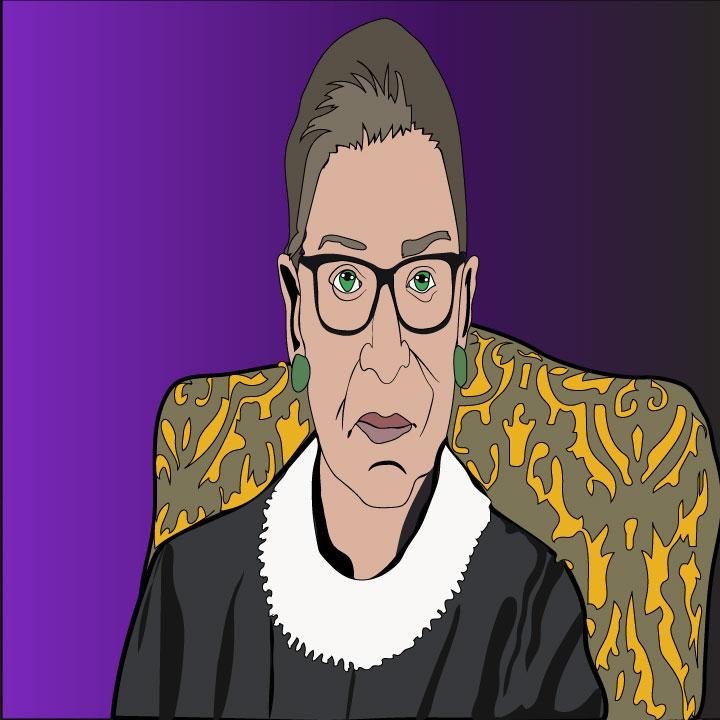By Cassandra Yany
Ruth Bader Ginsburg died Friday after her long battle with cancer. The 87-year-old Supreme Court justice was a trailblazer who continuously worked to end gender discrimination and preserve our civil liberties.
The Supreme Court announced Friday that Ginsburg passed away at her Washington D.C. home due to complications from metastatic pancreatic cancer. She had previously overcome lung, liver and colon cancer. In July, she revealed that the cancer had returned, but that she would continue to serve on the Supreme Court.
Ginsburg’s revolutionary career started when she graduated at the top of her class from Cornell University, earning a Bachelor’s degree in government. Two years later, she attended Harvard Law School with her husband, Martin Ginsburg. There, she was one of only nine women in her class of over 500 students, according to NPR.
During their time at Harvard, Martin was diagnosed with testicular cancer, so Ruth would take notes for the two of them and help him with his work, all while trying to juggle being a new mom. When Martin landed a job at a firm in New York, the family packed up and Ruth finished her education at Columbia University.
Once Ginsburg finished school, she began to experience the discrimination that came with being a female lawyer. According to TIME, she was unable to secure a position at a premier law firm or one of the Supreme Court clerkships, regardless of the fact that she had been the first students to serve on both the Harvard and Columbia Law reviews, and graduated at the top of her class. These jobs were instead easily given to males who had ranked lower than her in school. This led her to work a lower court clerkship and teach at the Rutgers Law Newark campus.
At Rutgers, she co-founded the Women’s Rights Law Reporter. While she was there, she learned that she wasn’t earning the same wage as one of her male counterparts. The dean attributed this pay disparity to the fact that the male professor had a family to support, while Ginsburg’s husband already had a good-paying job. This type of discrimination caused her to hide her second pregnancy.
After her son was born, Ginsburg began teaching at Columbia, becoming the university’s first tenured female professor. There, she also co-authored the first case book on discrimination law. She later went on to co-found the Women’s Rights Project of the American Civil Liberties Union in 1972.
During her work as a lawyer, Ginsburg established that equal protection under the law, as stated in the 14th Amendment, should extend to gender. She won five out of the six cases that she argued before the Supreme Court on gender discrimination. She often chose to find this prejudice in cases where males were the plaintiffs being discriminated against, as seen in the 2018 film On the Basis of Sex.
In 1980, Jimmy Carter appointed Ginsburg as a judge in the U.S. Court of Appeals for the District of Columbia. She became the second woman on the Supreme Court, and the first Jewish justice since 1969 when she was appointed by Bill Clinton in 1993. During her time, she eliminated almost 200 laws that discriminated against women.
Ginsburg also fought for the rights of immigrants, the mentally ill, and members of the LGBTQ+ community. She approved gay marriage in the case of Obergefell v. Hodges, stating that if you can’t deny a 70-year-old couple the right to marriage due to their inability to procreate, you can’t deny a gay couple of that right either.
Ginsburg supported women’s reproductive rights, fighting for the coverage of contraceptives despite anyone’s religious beliefs. At the time of Roe v. Wade, she litigated a case where a pregnant Air Force captain was told she would have to have an abortion in order to return to her job. She noted the hypocrisy present in this case— that the U.S. government was encouraging abortion – and found that it served as a clear example of why women should have the right to make their own life decisions.
Ginsburg’s passing gives Senate Majority Leader Mitch McConnell and President Trump the ability to appoint a new justice, despite her dying wish to not be replaced until after a new president is elected. This opportunity could make the Supreme Court more right-leaning and jeopardize cases like Roe v. Wade that are at the forefront of equal rights movements.
This comes four years after McConnell’s 11-month Republican blockade of President Obama’s nominee for the court, where he argued “that a president shouldn’t be able to seat a new justice in the final year of their term.” Obama noted this in a statement released early Saturday, where he said “A basic principle of law— and of everyday fairness— is that we apply rules with consistency, and not based on what’s convenient or advantageous in the moment.”
After the news broke Friday night of Ginsburg’s death, hundreds of people gathered outside the Supreme Court to pay tribute and create a memorial on the building’s steps. Many signs have since been left outside of the court honoring her legacy.
New York Gov. Andrew Cuomo announced Saturday morning that there will be a statue built in Ginsburg’s hometown of Brooklyn to “serve as a physical reminder of her many contributions to the America we know today…”
Trump issued a proclamation Saturday ordering flags to be flown at half-staff until sunset on the day of interment “As a mark of respect for Ruth Bader Ginsburg…”
RBG will be dearly missed by Americans on both sides of the aisle. We have lost a longtime champion of equal rights, but her legacy will never be forgotten.






